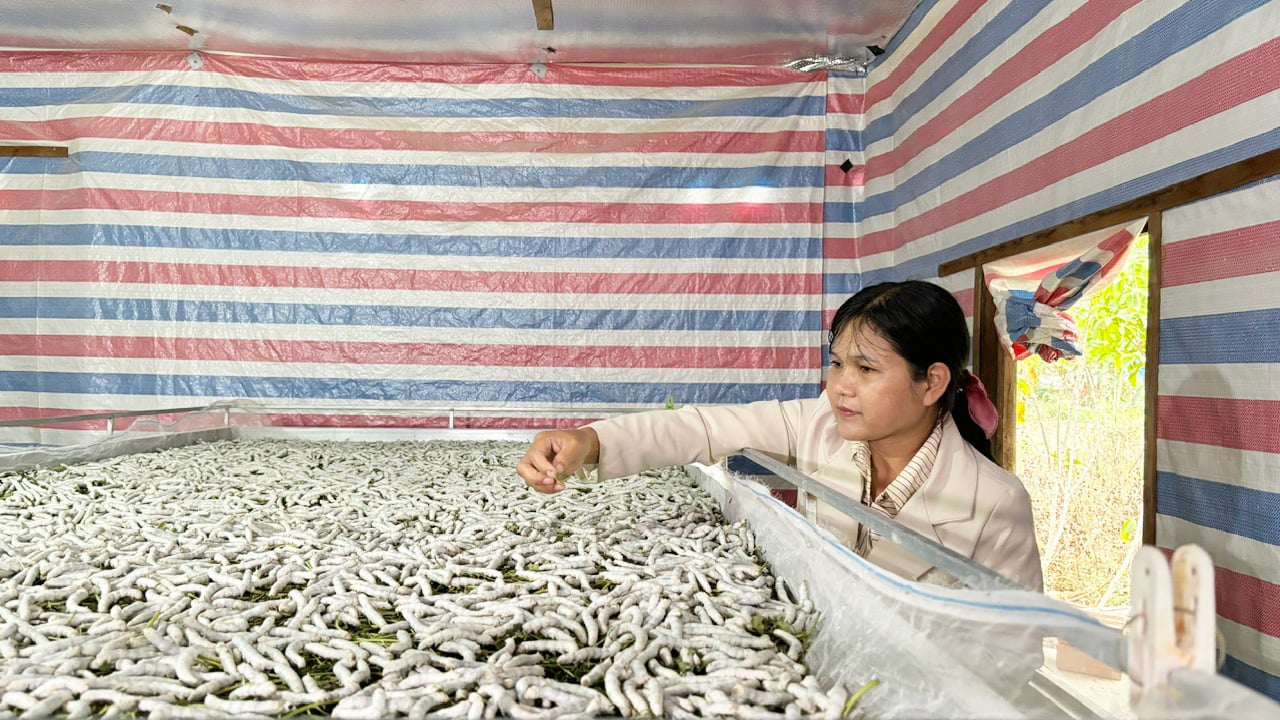 |
| Raising silkworms on iron shelves in Cheng village |
• SILKWORM BRINGS WARMTH AND PROSPERITY
Mr. Cil Muc Ha Chu's family has just sold a batch of cocoons for 250,000 VND/kg. This is the high price of Dam Rong silkworm cocoons. Along with Mr. Ha Chu, dozens of households in Cheng hamlet, Village 4, Da Long commune, Dam Rong district are working with mulberry gardens and silkworm trays every day.
Ms. Kơ Liệt K'Ôn - Vice President of the Farmers' Association of Đà Long Commune said that the Cheng village is a part of Village 4, an old name left by their ancestors, home to nearly 200 households of the K'Ho Cil people. In the past, the Cheng villagers lived mainly on wet rice fields along the small stream. The Cheng villagers' fields were interspersed with large rocks, creating a beautiful landscape but difficult to cultivate. Each wet rice field was tiny, built into cells to retain water for the rice plants. Therefore, the already small rice area became even smaller, and the Cheng villagers had to find other sources of income.
Ms. Krajăn K'Đen is busy picking mulberry for the silkworms to eat at home. She said that before, her family's two low fields were mainly used to grow rice for the family to eat. Seeing that the villagers were raising silkworms very successfully, at the end of the rainy season in 2023, she was determined to renovate the rice fields, switching to growing the high-yield mulberry variety S7-CB. Then, when the mulberry trees had grown branches and green leaves, in February 2024, she participated in a training class on growing mulberry and raising silkworms organized by the Commune Farmers' Association. "The first time I touched a silkworm, I was scared. But then, with the guidance of other sisters, I also took care of silkworms and picked mulberry. Then I got used to it, fed the silkworms, went up to the cocoon to peel the cocoons, and now, I also think that my silkworm raising ability is quite good," Ms. K'Đen smiled, recalling the first days of learning the trade. She said that her family was supported by the district's Department of Agriculture with trays, baskets, and tools for raising silkworms. Silkworms raised in Cheng village grow quickly, and in just 15 days they produce a batch of pure white cocoons. With two acres of mulberry trees, she raises one box of silkworms each month, working in two shifts. After deducting expenses, she earns 9-10 million VND/month, enough to cover her family's living expenses.
Ms. K'Den's family chose the silkworm farming model on a fixed iron rack, the advantage is that the area is compact, the quantity of silkworms is large and it is suitable for the initial investment conditions. For more than a year now, thanks to the mulberry growing and silkworm farming, Ms. K'Den and her family have had a more stable source of income.
• UNITY TO DEVELOP SILKWORM PROFESSION
Ms. K'On shared that silkworm raising is a traditional occupation of the Kinh people, while the K'Ho and M'nong people are less familiar with this animal. Since 2018, seeing the stable price of cocoons as well as the ability to earn a very quick income, Da Long commune has had a policy to encourage indigenous households to convert part of their low-yield rice fields or river and stream channels to grow mulberry and raise silkworms. Ms. K'On herself is one of the first people to raise silkworms in Da Long land. Learning the profession and raising high-yield silkworms in her family, Ms. K'On, like many other women, taught the K'Ho Cil and M'nong households. "The vocational training class guides women by holding hands and showing them how to do it, taking them to the homes of families that are raising silkworms, instructing them on how to cut mulberry, feed silkworms at the age of three and four, and clean the environment... so that silkworms can achieve high productivity," Ms. K'On shared.
According to Ms. K'On, Cheng village's land is not much, mainly rice fields mixed with boulders or land along rivers and streams, so the area is not large. Usually, women guide each other on how to raise silkworms by picking leaves instead of cutting branches like some areas with large areas. When the mulberry is 3 months old and about 80 cm high, start picking leaves from the base to the top. When the mulberry is 12 months old and has grown to about 1.5 m, and the yield has decreased, families are instructed to lower the trunk and cut the mulberry trees down to rejuvenate the mulberry garden. With the above economical picking method, even with a small area, during the dry season, Cheng villagers still have enough mulberry to maintain silkworm farming, helping families have a steady monthly income.
Therefore, along with the stable price of silkworm cocoons, the mulberry growing area is growing more and more. Currently, the whole village has 20 households raising silkworms and more households have registered to attend weekly training classes. The silkworm raising class is held every Saturday and Sunday, instructing households to raise silkworms at home to apply the techniques taught in the class. "For example, the mulberry must be clean, and if it gets wet from rain, it must be dried before feeding it to the silkworms. In addition, the State supports the bamboo trays and nets with a support level of 70%, so the people in the village are very excited," informed Ms. Ko Sa K' Bich.
Ms. K'Bich's family also converted 2 sao of mulberry from rice-corn land to silkworm farming. Ms. K'Bich said that the mulberry growing and silkworm raising class instructed the silkworm house and the nets to be cleaned very carefully. After harvesting the cocoons, the nets must be washed, dried, and then sprayed with a hot air gun to clean the nets, so that the next batch of silkworms can fully cocoon.
Not only guiding Cheng traders in raising silkworms, the training class also organized women into groups, supporting each other in the process of planting mulberry and raising silkworms. Households in the village shared mulberry varieties and experiences as well as lent each other trays and nets to families in the peak silkworm season who did not have enough tools. The sharing and mutual support between families helped Cheng traders to increasingly prosper, bringing batches of pure white cocoons to the rocky land.
Source: https://baolamdong.vn/kinh-te/202504/nguoi-buon-cheng-trong-dau-nuoi-tam-tren-ruong-da-0ca21f8/


![[Photo] Impressions of the Can Gio Whale Festival](https://vphoto.vietnam.vn/thumb/1200x675/vietnam/resource/IMAGE/2025/10/09/1759984089762_image12334-5642-jpg.webp)




![[Photo] Prime Minister Pham Minh Chinh chairs the Conference to deploy the National Target Program on Drug Prevention and Control until 2030](https://vphoto.vietnam.vn/thumb/1200x675/vietnam/resource/IMAGE/2025/10/09/1759990393779_dsc-0495-jpg.webp)




















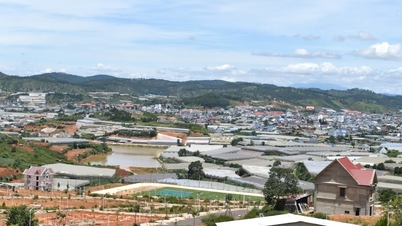


























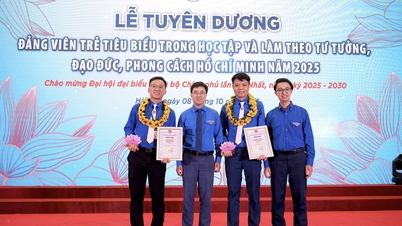




















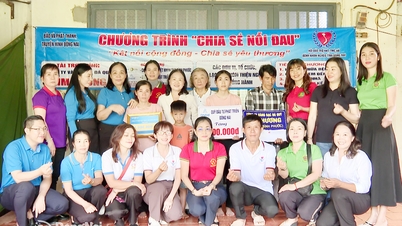




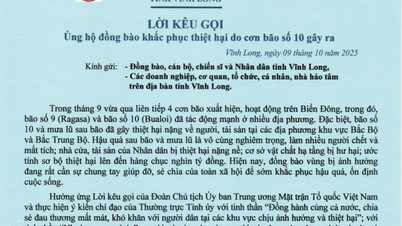








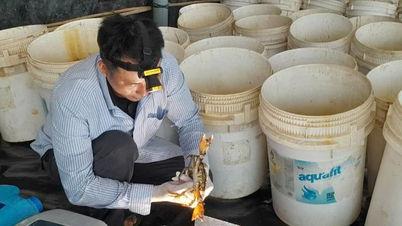





Comment (0)